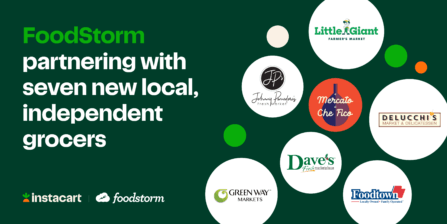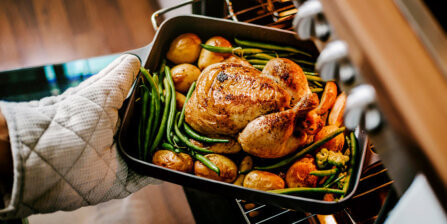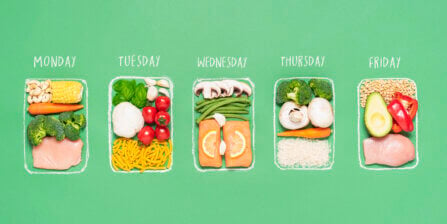FoodStorm
Ten Ways to Drive Profitability with Perimeter Departments

How Are You Growing Your Grocery Margins?
It’s no secret: Bigger profit margins support better business growth. For grocers, though, increasing margins can feel like an uphill battle. Historically, grocery has produced lower profit margins than other industries, with averages hovering around 2%. This likely comes as no surprise — between high stocking costs, revenue splits with CPG partners, and typical overhead, there are several factors that often eat into grocery revenue.
Fortunately, grocers have cornered a powerful solution for boosting profit margins and supporting a healthy in-store revenue cushion. That solution is in perimeter departments, where consumers can find:
- Deli items
- Made-to-order sandwiches
- Bakery goods
- Cafe-style products
- Catering services
- Fresh florals
By leaning into this opportunity, grocers can leverage growing consumer affinity for prepared foods, order ahead foods, and catering services to support higher grocery margins.

We’ve identified ten tips across prepared foods, order ahead, and omnichannel strategies that may help boost profitability. Explore these tactics, and see how you can jump on this burgeoning grocery trend.
Establishing a Grocery Perimeter
Consider how these tips can help you attract consumers to your prepared foods counters — and make your backend operations seamlessly margin-focused.
Tip #1: Craft a signature experience
Is your perimeter kitchen skilled at creating custom sandwiches, salads, or sides? Do you have a talented barista in house? Or does your floral department specialize in custom bouquets? Take stock of your in-store resources and current offerings that consumers are purchasing most often. By leaning into a specialized menu and curating one-of-a-kind perimeter products, you can use consumers’ existing affinity for your stores to build a custom perimeter experience unlike any other. As a result, you can strengthen your brand by offering products that meet expectations — and prioritize margin growth.
Tip #2: Make it a package
By creating customizable packages or combos, grocers can adjust their prices to support higher margins. For example, grocers can offer slight discounts when consumers bundle a hand-crafted lemonade with their made-to-order custom sandwich. Similarly, grocers can create discounts on catering orders of 20 meals or more, and charge a slightly higher price for an order with fewer than 10 meals. This way, consumers feel they receive a fair price while incrementally increasing their basket sizes — and grocers can leverage flexible pricing to support a healthier margin.
Tip #3: Add a personal touch
For more personalization opportunities, grocers can leverage add-ons or upsell recommendations to every order from their prepared foods counters. A bakery department, for example, can offer a discounted rate on a dozen cookies when a consumer buys a custom cake. Additionally, grocers can charge a slight premium for side dishes made in house, and serve simple add-to-cart notifications for the dishes when consumers shop digitally. By positioning these items as custom offers for individual consumers, grocers generate demand — and support healthier margins.
Tip #4: Simplify and streamline
By delivering prepared foods orders with a sustainably efficient cadence, grocers facilitate better in-store experiences for consumers. As a result, satisfied consumers are more likely to become routine shoppers, and even provide word-of-mouth referrals to generate higher usage.
Consider how your current tech stack supports your perimeter services. Do you have an effective order management system (OMS) that simplifies orders for consumers? Does it streamline your backend operations? If your staff are struggling to maintain productivity, it may be time to adopt a new OMS like FoodStorm that’s capable of handling higher order volumes.

*Prior results do not guarantee future outcomes.
When it comes to perimeter departments, grocers can use a variety of pricing, inventory, and optimization tactics to support higher margins. But how can grocers specifically boost profit margins with single-serve items?
Stronger Grocery Margins with Made-to-Order Strategies
At Instacart, we’ve seen grocers leverage innovative solutions to increase engagement, like made-to-order kiosks placed throughout stores. They’ve also integrated grocery delivery services to strengthen CPG offerings. Today, grocers are adopting similar tactics to boost margins with their prepared foods counters. Let’s take a closer look.
Tip #5: Encourage adventurous behaviors
Ordering ahead from a prepared foods counter can be an exciting experience for younger shoppers who enjoy trying unique food combinations in a grocery store setting. Grocers can use this affinity to their advantage. Offering trendy order ahead combos based on relevant cultural moments, attractive pastry decorations, and seasonally themed foods can appeal to a trend-focused demographic. As a result, grocers can boost consumer engagement — and assign higher values to traditionally low-margin products.

Tip #6: Offer ordering to go
As consumers become increasingly tech savvy, they prefer perimeter experiences that offer seamless order ahead capabilities. Leaning into this demand can help boost sales for made-to-order products, and also support a more competitive ecosystem where tech-attuned grocers have the upper hand. By opting for order ahead technology designed for prepared foods counters, grocers can differentiate themselves and please consumers in a profit-focused way.
Tip #7: Embrace digitization
Grocers can use powerful order ahead services and digital kiosks to support their perimeter counters.
Imagine your store offers made-to-order sandwiches. To effectively navigate a lunch rush, your kitchen staff needs to prepare orders correctly, reduce product waste, and protect margins all at once. They can do this most effectively with a kitchen display system (KDS) that integrates with a digital ordering kiosk to increase backend visibility, even in high volume situations.
By using KDS and digital ordering kiosks, you can digitize the ordering experience to streamline made-to-order kitchen lines — and facilitate consistent order quality for your consumers.
Support Stronger Margins with Prepared Foods Technology
Between OMS, KDS, and online ordering platforms, there are a number of tech opportunities that grocers can leverage to support higher profit potential. But what are the strongest ways to onboard prepared foods technology? Let’s explore three tactics.
Tip #8: Use an e-commerce platform
If your stores already use an online storefront for center aisle products, you can feature order ahead and catering services there, as well. E-commerce platforms designed for grocers, like Storefront Pro, use AI-powered technology to show consumers the products they’re most likely to purchase. Consider how you can use an e-commerce platform to feature high-margin items, like cheeses, to get the most out of this opportunity.
Tip #9: Add prepared foods to (smart) cart
Grocers worldwide are exploring the potential of smart shopping carts, which use digital touchscreens, scanners, and scales to make in-store shopping experiences feel upscale and adventurous. With solutions like Caper Carts, you can feature order ahead services for custom products on the cart screen to seamlessly encourage orders — and boost your grocery margins. If your store already uses smart carts, this is also a powerful strategy for boosting your tech ROI.
Tip #10: Create a perimeter ecosystem
Adopting grocery technology can empower you to unite your perimeter departments and enable an all-in-one management system that naturally supports higher grocery margins.
Solutions like FoodStorm can help you boost margins by:
- Eliminating reporting redundancies
- Reducing tool sprawl for your tech department
- Increasing data visibility among order ahead, catering, and perimeter departments
So, how can FoodStorm unlock all these capabilities? Imagine you’re preparing an end-of-quarter report for your perimeter departments. With FoodStorm, you can easily measure the impact of departments like order ahead and catering on grocery margins by comparing their utilization numbers in a single dashboard. With this data, you can build an informed strategy that helps boost sales.
Embrace Margin-Boosting Strategies with FoodStorm
FoodStorm is widely beloved by grocers, retailers, and caterers around the world — and it’s customizable to your needs. Whether you’re looking for a full-scale solution to integrate across an enterprise, or just curious how integrating an OMS can boost your sandwich counter’s productivity, FoodStorm has something for you.
See how you can streamline backend production and strengthen frontend margins with FoodStorm today!
If you’re interested in Instacart Platform technology for your grocery business, click the button below to submit a Retailer Inquiry form.
Most Recent in FoodStorm

Company Updates
Holiday Ordering Simplified: FoodStorm’s New Capabilities Enhance Prepared Food Retail Operations
Improved in-store fulfillment functionality and stock management will help boost retail sales As the holiday season approaches, grocers are gearing up for the annual surge in prepared food and catering orders. To prepare for the…
Sep 18, 2024
FoodStorm
Elevate Your In-Store Prepared Foods Experience with Grocery Kiosk Technology
Bringing Digitization to Perimeter Departments Between online shopping solutions like digital storefronts and in-store touchpoints like electronic shelf labels, we’re seeing the next evolution of grocery technology happen in real time. Retailers are leveraging the…
Aug 12, 2024
Company Updates
Helping Local Independent Grocers Streamline Their Catering and Prepared Foods Businesses
Over the past few years, FoodStorm - our order management system (OMS) designed specifically to help grocers manage their deli, prepared foods and catering - has seen remarkable growth. And today, we’re excited to share…
Apr 24, 2024

 Cooking Time Calculator: Prepping, Baking and Meat Temperature Guide
Cooking Time Calculator: Prepping, Baking and Meat Temperature Guide  25 Easy Meal Planning Ideas for Families + Tips
25 Easy Meal Planning Ideas for Families + Tips  63 Super Bowl Recipes That Will Score Big With Your Guests
63 Super Bowl Recipes That Will Score Big With Your Guests 
